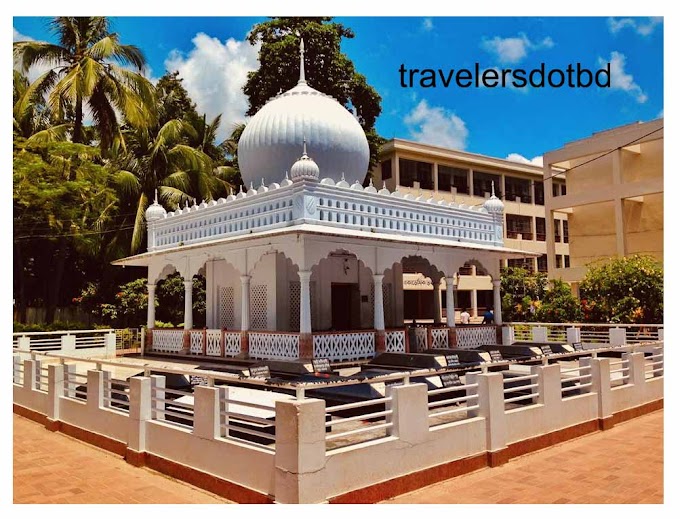Jhaudiya Shahi Mosque
 |
| Jhaudiya Shahi Mosque |
Throughout the ages, innumerable missionaries, saints and saints have come to Bengal from different countries. Their main objective was to spread Islam and alleviate the suffering of the people. Zamindar Shah Sufi Syed Ahmed Ali (Adari Mia Chowdhury) came to Kushtia's Jhaudia area from Baghdad during the reign of Mughal Emperor Aurangzeb for the same purpose.
For the convenience of propagating Islam and in the spirit of worship of Allah, he established a mosque in Jhaudia, which is known as Jhaudia Shahi Mosque. About 25 km south-west of Kushtia town, in the middle of Jhenaidah and Kushtia districts, in the village of Jhaudia in Kushtia Sadar upazila, is a witness to history.
Jhaudia Shahi Mosque in Kushtia Sadar Upazila. It is a common saying, "The jinn built this mosque in one night." Some claim that the mosque came out of the ground at night.
However, it is man-made, the soil did not come out, said some senior worshipers in the area.
The main mosque has three handsome domes, three doors, and three prayer rows. Beautiful antiquities on the inner wall of the whole mosque. The mosque has a beautiful veranda and a huge main gate. There are also two domes a short distance from the main gate. The royal mosque was built in a 52-inch masonry with earthenware, lime and surki. The three-domed mosque has two beautiful flower windows made of lime and surki on the north and south sides.
 |
| Jhaudiya Shahi Mosque |
The main mosque has three handsome domes. Another peculiarity of the mosque is that the alpana painted on its entire wall does not match any of them. Each alpana in a new design. Due to its thick masonry with tile, lime and surki, the mosque is cold on hot days and slightly warm on winter days. There is no provision for ceiling fan inside the mosque. However, if the temperature is high, some air is given with a few fan fans.
Under the three domes inside the historic Jhaudia Shahi Mosque, about 100 worshipers can perform prayers in 3 rows. Others stand on the porch of the mosque.
Kushtia Islamic University official and local resident Shafiqul Islam Chowdhury said the mosque was built during the reign of Aurangzeb. This is because the construction style of this mosque is very similar to other structures built during the Mughal period. The Jhaudiya Shahi Mosque was built following the Mughal architectural style.
He added that people from far and wide come to the mosque to offer prayers. About 4-5 thousand people come to this mosque on Fridays of other months except Ramadan.
There is no similarity between any of the walls. Another local worshiper, Selim Uddin Chowdhury, said the exterior of the mosque was a bit dull due to lack of maintenance, but the dazzling design inside did not cause much damage. The mosque was registered by the Department of Archeology in 1979. The last time the mosque was renovated was in 1979-80. Devotees from different areas come to offer prayers and many take vows here.
 |
| Jhaudiya Shahi Mosque |
Asked about the establishment of the mosque, he said, "Everyone hears it, we know what grandparents have said." Shah Safi Syed Ahmed Ali (Adari Mia Chowdhury) established this mosque for the purpose of propagating Islam. He spent most of the day in the mosque worshiping. He used to come every day to perform prayers and sit in a room next to the mosque. There he would tell everyone about religion. Zamindar Shah Sufi Ahmad Chowdhury himself was the Imam. He used to teach Qur'an to the people of the area. Religious Adari Mia Chowdhury was unmarried. His shrine is a short distance from the mosque.
Beautiful antiquities inside the mosque. He further said that according to the agreement with the Department of Archeology, Hasan Ali Chowdhury or his descendants will be the mutawalli (caretaker) of the mosque. He and his descendants are running the mosque. At present Maulana Md. Mokaram Hossain is acting as the Imam and Khatib of this mosque. Earlier, Mokaram Hossain's father Abdus Shukur, before him Mokaram Hossain's uncle Manjarul Alam and before him Mokaram Hossain's grandfather Maulana Maula Box were in charge.
The traditional Jhaudia Shahi Mosque has further enriched the mosque-tradition of Bangladesh. This is one of the symbols of Islam in the Mughal period. This mosque carries the rich Muslim heritage of Bengal. Hundreds of tourists visit Jhaudia village every day to visit this traditional mosque.



0 Comments